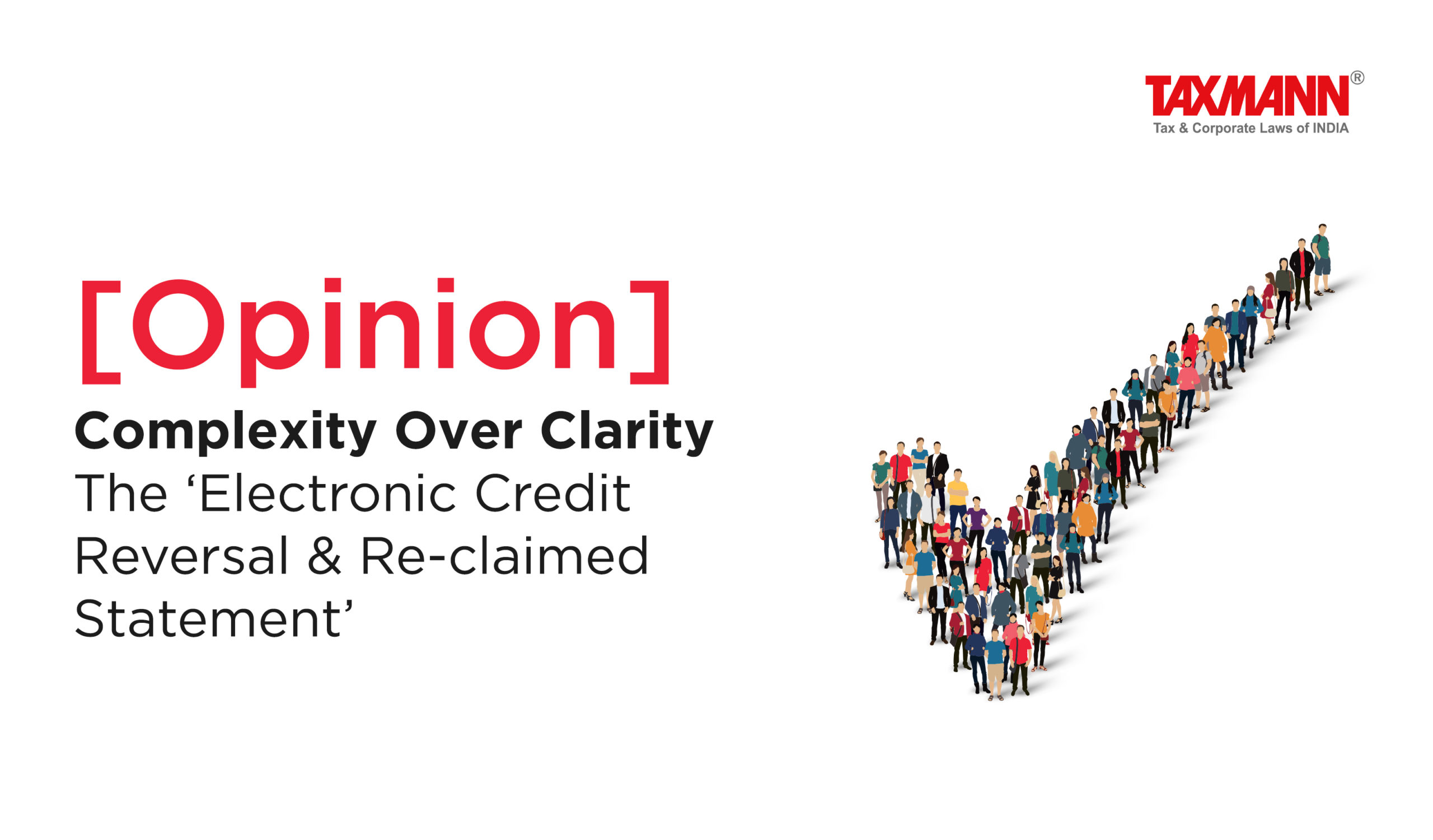[Opinion] Complexity Over Clarity | The ‘Electronic Credit Reversal & Re-claimed Statement’
- Blog|News|GST & Customs|
- 3 Min Read
- By Taxmann
- |
- Last Updated on 4 September, 2023
Anshul Mittal – [2023] 154 taxmann.com 37 (Article)
The Indian Government has taken significant steps to streamline the Goods and Services Tax Network (GSTN) and ensure that taxpayers report precise information regarding Input Tax Credit (ITC) availed, ITC reversal, ITC re-claimed, and ineligible ITC. However, this move of the Govt. has left many taxpayers scratching their heads. While the intention is to ensure accurate reporting, the execution raises significant concerns. These changes, outlined in Notification No. 14/2022 – Central Tax dated 05th July, 2022, and circular No. 170/02/2022-GST, Dated 6th July, 2022, introduce a new feature called the “Electronic Credit Reversal and Re-claimed Statement” on the GST portal. While these changes appear well-intentioned, a closer look reveals potential pitfalls that taxpayers must be wary of.
1. Introduction of the Electronic Credit Reversal and Re-claimed Statement: A new statement, called the “Electronic Credit Reversal and Re-claimed Statement,” is being introduced on the GST portal. This statement is designed to help taxpayers track ITC that has been reversed in Table 4B(2) and subsequently re-claimed in Table 4D(1) and 4A(5) for each return period, starting from the August return period.
The creation of the “Electronic Credit Reversal and Re-claimed Statement” initially seems like a useful tool for taxpayers. However, the devil is in the details. Taxpayers are now burdened with tracking ITC reversals and re-claims using this statement. This adds yet another layer of complexity to an already intricate GST filing process. Will this statement truly simplify matters, or is it just another layer of bureaucracy?
2. Alignment of Reclaimed ITC with Reversed ITC: This statement aims to ensure that when taxpayers reclaim ITC in GSTR-3B, the amount aligns appropriately with the corresponding reversed ITC. This is intended to improve the consistency and correctness of ITC reversal and re-claims.
Aligning reclaimed ITC with reversed ITC sounds sensible in theory. However, the practical execution of this alignment remains a concern. While the goal is to ensure consistency and correctness in reporting, it might inadvertently introduce more red tape for taxpayers. The government should provide clarity on how this alignment will be achieved without becoming a compliance nightmare.
3. Reporting Cumulative ITC Reversal Opening Balance: Taxpayers have the option to report their cumulative ITC reversal (ITC that has been reversed earlier and has not yet been reclaimed) as an opening balance for the “Electronic Credit Reversal and Re-claimed Statement.” The reporting of this balance should consider ITC reversal activities until specific return periods:
-
-
- Monthly taxpayers should report their opening balance considering the ITC reversal done until the return period of July 2023.
- Quarterly taxpayers should report their opening balance up to Q1 of the financial year 2023-24, considering the ITC reversal made until the April-June 2023 return period.
- Taxpayers have until 30th November 2023 to declare their opening balance for ITC reversal, with three opportunities for amendments during this period. After 30th November until 31st December 2023, only amendments will be allowed, and no fresh reporting will be permitted.
-
While the provision for a cumulative ITC reversal opening balance may seem generous, it comes with certain stipulations. Taxpayers are expected to report this balance accurately, taking into account previous reversal activities. Failure to do so could result in compliance issues. This might not be as beneficial as it appears, as it places additional reporting responsibilities on taxpayers, potentially leading to confusion and mistakes.
Click Here To Read The Full Article
Disclaimer: The content/information published on the website is only for general information of the user and shall not be construed as legal advice. While the Taxmann has exercised reasonable efforts to ensure the veracity of information/content published, Taxmann shall be under no liability in any manner whatsoever for incorrect information, if any.

Taxmann Publications has a dedicated in-house Research & Editorial Team. This team consists of a team of Chartered Accountants, Company Secretaries, and Lawyers. This team works under the guidance and supervision of editor-in-chief Mr Rakesh Bhargava.
The Research and Editorial Team is responsible for developing reliable and accurate content for the readers. The team follows the six-sigma approach to achieve the benchmark of zero error in its publications and research platforms. The team ensures that the following publication guidelines are thoroughly followed while developing the content:
- The statutory material is obtained only from the authorized and reliable sources
- All the latest developments in the judicial and legislative fields are covered
- Prepare the analytical write-ups on current, controversial, and important issues to help the readers to understand the concept and its implications
- Every content published by Taxmann is complete, accurate and lucid
- All evidence-based statements are supported with proper reference to Section, Circular No., Notification No. or citations
- The golden rules of grammar, style and consistency are thoroughly followed
- Font and size that’s easy to read and remain consistent across all imprint and digital publications are applied








 CA | CS | CMA
CA | CS | CMA



what starting period is taken for cumulative ITC opening balance reported in Electronic credit reversal & reclaimed statement
For Monthly taxpayers, the specified return period pertains to August 2023. For those filing quarterly returns, the specified return period corresponds to Q2 of the financial year 2023-24, encompassing the months of July September 2023.